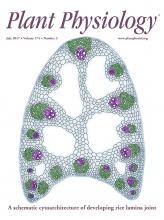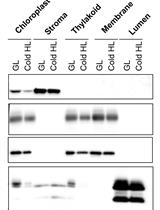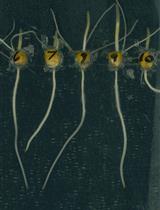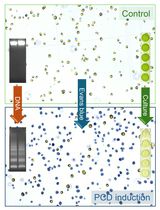- 提交稿件
- 订阅
- CN
- EN - English
- CN - 中文
- EN - English
- CN - 中文
Monitoring Xylem Hydraulic Pressure in Woody Plants
木本植物中木质部液压的监测
发布: 2017年10月20日第7卷第20期 DOI: 10.21769/BioProtoc.2580 浏览次数: 9080
评审: Marisa RosaValérie CornuaultCarsten Patrick Ade
Abstract
Xylem sap circulates under either positive or negative hydraulic pressure in plants. Negative hydraulic pressure (i.e., tension) is the most common situation when transpiration is high, and several devices have been developed to quantify it accurately (e.g., Scholander pressure chamber, psychrometers). However, a proper measurement of positive xylem sap pressures may be critical when pressure is generated by the root system, allowing vessels to be refilled. Here, we describe two different methods to monitor positive xylem bulk pressure: the pressure gauge which can only be set onto a rootstock or a side branch and the point pressure sensor, which can allow measurements from a functioning plant without detopping or cutting.
Keywords: Pressure (压力)Background
Although plants can recover from critical levels of xylem embolism, < 50% loss of hydraulic conductivity in conifers (Brodribb and Cochard, 2009) and < 88% in angiosperms (Urli et al., 2013), the exact mechanism is still under debate. The ascent of sap is driven by the evaporative demand from the atmosphere, which generates a negative pressure (i.e., tension) in the water column and hydrogen bonds between molecules (i.e., cohesion) pull the sap through the plant via the well accepted cohesion-tension theory (Dixon, 1896; Angeles et al., 2004). However, positive xylem sap pressure can be recorded under particular conditions, for example water-saturated soil combined with very low transpiration. This mechanism has been shown to refill embolized vessels in springtime (Sperry et al., 1994) and in species that experienced freeze-thaw induced embolism (Charrier et al., 2013 and 2014). Refilling of embolized vessels has been hypothesized to occur under both positive and negative xylem sap pressures in Laurus sp or Vitis sp, for example (Salleo et al., 1996). However, the ‘refilling under tension’ mechanism is inconsistent with the cohesion-tension theory (Zwieniecki and Holbrook, 2000). Moreover, recent works suggest that refilling occurs only under positive pressure in Vitis (Charrier et al., 2016). The dynamic changes in xylem sap pressure therefore need to be explored at both the seasonal and diurnal scale while maintaining as much as possible the integrity of the hydraulic architecture of the plant.
Although the use of stem psychrometers has been extensively described since the 80’s (e.g., Dixon and Tyree, 1984; Tyree and Dixon, 1986), the measurement of positive xylem sap pressure is relatively rare. The protocol described here allows the quantification of the spatio-temporal pattern of bulk xylem sap water potential under positive pressures, and even moderate tensions (maximum of 0.05 MPa) along the water column using non-invasive sensors (i.e., point pressure sensors).
Materials and Reagents
- Parafilm M (Bemis, catalog number: PM996 )
- Stainless-steel hypodermic needle 21 G 1 ½” (Terumo Medical, catalog number: 8AN2138R1 )
- Union–1/16” PEEK (Interchim, catalog number: 869290 )
- Lock ring (Ark-Plas Products, catalog number: LEX66-PP0 )
- Threaded male Luer connector 10-32 UNF (Ark-Plas Products, catalog number: LGX74-PP0 )
- Reinforced PVC flexible tubes (RS Components, catalog number: 440-874 )
- Zip ties e.g., RS Pro Black Nylon Non-Releasable Cable Tie, 300 x 4.8 mm (RS Components, catalog number: 233-487 )
- 4-way Luer Lock Stopcock, Male-Male-Female (Cole-Parmer, catalog number: EW-30600-04 )
- Stainless steel high quality single edge blades (e.g., Mure & Peyrot, catalog number: 144.3 )
- Nylon Hose clips (RS Components, catalog number: 291-587 )
- Cutting disk (RS Components, catalog number: 448-7439 )
- HSS Drill bit, 0.8 mm diameter (e.g., RS Components, catalog number: 457-651 )
Note: Most parts are available from the laboratory equipment suppliers.
Equipment
- High resolution datalogger (e.g., Campbell Scientific, model: CR1000 )
- Pressure transducer 30Psi (Honeywell International, catalog number: 26PCDFA6D )
- Stabilized power supply 12V DC (e.g., Traco Power, catalog number: TML 20212C )
- Hand-held driller
Procedure
文章信息
版权信息
© 2017 The Authors; exclusive licensee Bio-protocol LLC.
如何引用
Readers should cite both the Bio-protocol article and the original research article where this protocol was used:
- Charrier, G., Burlett, R., Gambetta, G. A., Delzon, S., Domec, J. C. and Beaujard, F. (2017). Monitoring Xylem Hydraulic Pressure in Woody Plants. Bio-protocol 7(20): e2580. DOI: 10.21769/BioProtoc.2580.
- Charrier, G., Torres-Ruiz, J. M., Badel, E., Burlett, R., Choat, B., Cochard, H., Delmas, C. E., Domec, J. C., Jansen, S., King, A., Lenoir, N., Martin-StPaul, N., Gambetta, G. A. and Delzon, S. (2016). Evidence for hydraulic vulnerability segmentation and lack of xylem refilling under tension. Plant Physiol 172(3): 1657-1668.
分类
植物科学 > 植物生理学 > 非生物胁迫
您对这篇实验方法有问题吗?
在此处发布您的问题,我们将邀请本文作者来回答。同时,我们会将您的问题发布到Bio-protocol Exchange,以便寻求社区成员的帮助。
提问指南
+ 问题描述
写下详细的问题描述,包括所有有助于他人回答您问题的信息(例如实验过程、条件和相关图像等)。
Share
Bluesky
X
Copy link












